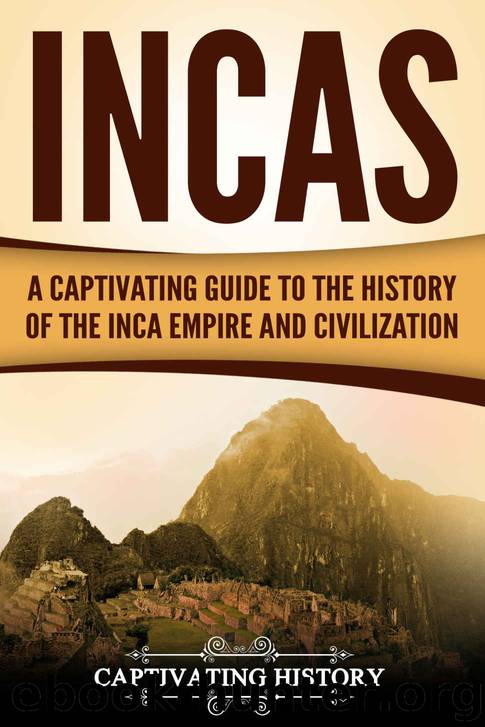Incas: A Captivating Guide to the History of the Inca Empire and Civilization by Captivating History

Author:Captivating History [History, Captivating]
Language: eng
Format: azw3, epub
Published: 2017-12-01T16:00:00+00:00
Chapter 10 – Tour of the Greatest Inca Sights
The environment of the area that used to be the ancient Inca Empire is truly spectacular. If you take a road trip from Lima, the central coast of Peru and travel about 200km East, you would be starting your journey from the desert coast, passing through a mountain range and its snow-topped peaks, and eventually, end up in the Amazonian tropical rain forest. The Inca Empire included 20 of the world’s 34 major life zones, and you would pass from one to the next in within an hour of walking.
This naturally affected how the Incas built their homes and used their environment.
How the Incas constructed their homes
With such a vast mountain range covering a considerable portion of their empire, the Incas naturally constructed their homes high up, many miles above the sea level. About two-thirds of the population, in fact, lived some 3,300m above sea level. This also affected the way the locals could overcome the problem of high altitude, the Incas invented terrace farming. They built steps of land for agriculture down the mountainside, and this helped them to create flat lands even in the mountains. They also had a good irrigation system - the Incas could channel the rainwater through each step of the terraced lands. They also constructed aqueducts that helped them carry the water more efficiently to wherever it was needed.
Although this view may come from the Inca propaganda at the time, it is believed no one went hungry in the Inca empire. The common people may have eaten little meat, compared to the nobles, but everyone was well fed.
In fact, the Inca were the first society to grow potatoes, along with many other crops, such as corn and quinoa. These were the three staple crops of the Inca civilization, and the latter helped them to make many different dishes. These include flour, soups, and cereal. The Incas also ate a great variety of other fruit and crop - tomatoes, avocados, peppers, strawberries, peanuts, squash, sweet potatoes, beans, pineapple, bananas, spices. They also favoured coco leaves to make their chocolate drinks. They were no stranger to the sweeter things in life either as they kept honeybees.
According to some sources, the Inca grew so much food it had to be dried and kept in specially constructed storage buildings.
Due to the high altitudes, the climate was colder than on the mainland, and therefore better suited for storing food. So, the Incas put the food outside to freeze and stamped on it until all the water had gone. To finish the drying process, they left it out in the sun for a while.
Most notable Inca sacred sites
Many of the most impressive Inca religious sites are still visited today. Since everything in the Inca empire was tied up with their religious practices, many of these sites have been built according to the Inca sacred geometry.
Macchu Piccu
Download
Incas: A Captivating Guide to the History of the Inca Empire and Civilization by Captivating History.epub
This site does not store any files on its server. We only index and link to content provided by other sites. Please contact the content providers to delete copyright contents if any and email us, we'll remove relevant links or contents immediately.
The Daily Stoic by Holiday Ryan & Hanselman Stephen(2709)
The Fate of Rome: Climate, Disease, and the End of an Empire (The Princeton History of the Ancient World) by Kyle Harper(2436)
People of the Earth: An Introduction to World Prehistory by Dr. Brian Fagan & Nadia Durrani(2346)
Ancient Worlds by Michael Scott(2104)
Babylon's Ark by Lawrence Anthony(2070)
Foreign Devils on the Silk Road: The Search for the Lost Treasures of Central Asia by Peter Hopkirk(2056)
India's Ancient Past by R.S. Sharma(1988)
MOSES THE EGYPTIAN by Jan Assmann(1973)
The Complete Dead Sea Scrolls in English (7th Edition) (Penguin Classics) by Geza Vermes(1842)
Lost Technologies of Ancient Egypt by Christopher Dunn(1798)
The Daily Stoic by Ryan Holiday & Stephen Hanselman(1770)
The Earth Chronicles Handbook by Zecharia Sitchin(1744)
24 Hours in Ancient Rome by Philip Matyszak(1678)
Alexander the Great by Philip Freeman(1650)
Aztec by Gary Jennings(1545)
The Nine Waves of Creation by Carl Johan Calleman(1520)
Curse Tablets and Binding Spells from the Ancient World by Gager John G.;(1510)
Before Atlantis by Frank Joseph(1484)
Earthmare: The Lost Book of Wars by Cergat(1469)
